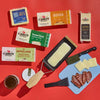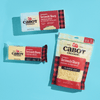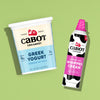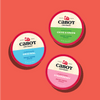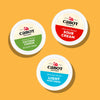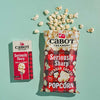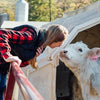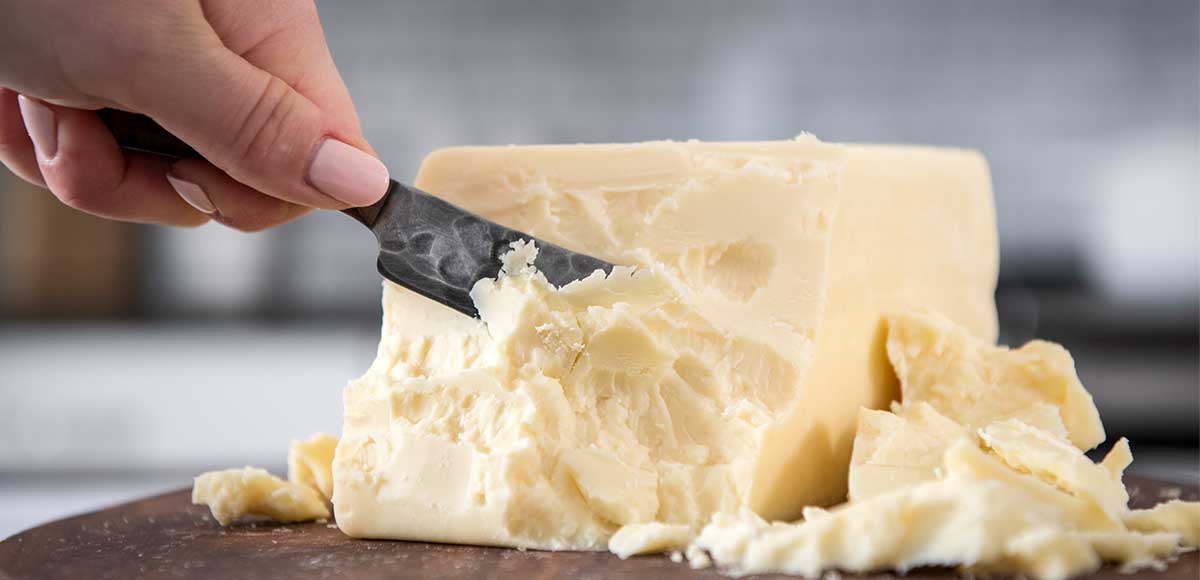
Cheese Glossary
Enjoy learning about cheese!
Our cheese glossary brings all your favorite cheese terms to one place. Find out essential cheese definitions to sound like a true fromager.
A
Acidity
A tart flavor in cheese caused by lactic acid.
Affineur
A person who ages (or “matures”) cheese. Many cheesemakers act as their own affineur, overseeing the aging of all their cheeses. At Cabot, our grading team leads this function.
Aged Cheese
A cheese that generally has been aged (i.e. ripened) six months or more. Aging typically causes cheeses to develop a sharper, stronger flavor, but not always.
Aging
A term for cheese ripening.
Annato
A natural orange coloring used in making orange cheddar
Artisan
Cheeses that are handmade in small quantities. These types of cheese can be made from milk obtained from animals located on the farm where the cheese is made, but don’t have to be.
B
Best Before Date
Date on package of cheese that identifies the date when the cheese will be at its best, assuming proper storage. Note that, while cheddar cheese does not go bad, it can continue to age slowly in the package.
Brine
A solution of salt water that some cheeses are stored in.
C
Casein
The most important protein in milk for cheesemaking. Coagulated casein can hold moisture like a sponge and then, when exposed to acid and heat, shrink and expel moisture. During the fermentation and ripening of cheese, casein is modified to create the structure and flavor of the specific cheese.
Cheddaring
A process used in the crafting of cheese that involves cutting curd into blocks, then turning and stacking the blocks at the bottom of the vat every 15 minutes for about 90 minutes in total. Traditionally, this was a very hands on process. However, at Cabot, this process is done on a large continuous cheddaring belt or, for extended stirring, on make tables.
Cheese Co-operative
While a traditional company is owned by individuals and outside investors who buy shares of the corporation, a co-operative is owned and operated by its members. Cabot is a cheese co-operative run by the family dairy farmers who are the source of our dairy products.
Clothbound Cheddars
A natural rind, bandaged cheddar. Clothbound cheddars have a crumbly texture, nutty aroma and savory flavor.
Coagulation
A process of thickening milk into a custard-like gel by introducing acid or rennet to it. In other words, what happens when milk solidifies and curds form.
Crumbly
A term used to describe a cheese that breaks away when cut.
Culture
The process of adding bacterial cultures to a product, such as cheese, to develop flavor.
Curd
The solids formed in curdled (or coagulated) milk that cheese is made from.
Curdling
The preliminary stage of cheesemaking in which the solids (curds) are separated from the liquids (whey).
Curing
Another term for "ripening".
D
Double Cream
A bloomy rind cheese with a milk fat content between 30% and 35%, and a moisture content of 50%.
Draining
The process by which whey is drained from the milk solids, just before pressing.
E
Enzyme
A substance used to promote the curdling of milk. These complex compounds are released by bacteria during the cheesemaking process and help to break down proteins or fats. Enzymes are important contributors to the flavor complexity in cheese.
Extra Aged
Cheese that has been aged over 2 to 7 years, but is not designated by year.
F
Farmstead Cheese
Cheese made on the same farm where the milk is produced.
Fat Content
Fat content can range from 4% to 75%. An average fat content is 45%. 3.5% to 4% for milk. Cheddar is around 33% to 35% butterfat. Cabot does not make any cheese near 45%.
Fermentation
The process that occurs during the cheese ripening process.
Flavored Cheese
Cheese that has particulates or flavoring added to it.
Fresh Cheeses
A category of cheeses that are not aged or ripened and retain much of the flavor of fresh milk.
Fromager
A cheesemaker; person who makes cheese.
G
Grating Cheddar
Any cheese that has been aged sufficiently to become firm enough to grate, such as Parmesan.
L
Lactose
The sugar that naturally occurs in milk. Aged cheeses like cheddar contain less lactose because the ripening process removes most of the lactose.
Lactose-free
Cheeses that have no lactose (milk sugar).
M
Moisture
The amount of liquid remaining in cheese. Moisture content in cheese is expressed as a percentage.
N
Natural Cheese
Cheese made from milk to which salt, enzymes and flavorings can be added.
Nutty
Typically refers to a hazelnut flavor.
P
Pasta Filata (i.e. Stretched Curd)
An Italian term for a cheesemaking technique in which the curd is stretched or kneaded in hot whey or water. This technique produces a firm, more elastic texture and is used to make cheeses such as Mozzarella and Provolone.
Pasteurization
The process of heating milk to high temperatures for a set period of time in order to destroy harmful bacteria.
Pressed Cheese
A cheese whose whey was not drained naturally but eliminated through a mechanical pressing process.
Pressing
The process of placing soft, wet cheese curds under pressure for the purpose of removing whey and minimizing fat loss.
Processed Cheese
A cheese made from a blend of similar cheeses (such as various Cheddars) which have been heated and melted together.
Q
Queso
Spanish word for cheese.
R
Raw Milk
Milk that has not been pasteurized. Cheeses made from raw milk are held for 60 days before being released to the public.
Rind
The protective external layer of a cheese. Rinds can be naturally or artificially created.
Ripening
The process and methods by which cheese mature and develop distinctive qualities. Proper ripening is critical to the full development of the characteristic flavor, color and texture of many types of cheese.
S
Salting
Adding salt during the cheesemaking process. This is done to slow the fermentation of lactic acid bacteria and dry the curd by drawing out the whey, as well as to enhance flavor. Salt can also be added through the brining process.
Sharpness
The term that indicates how cheddar changes in flavor and texture as it ages.
Shelf Life
The length of time a cheese will be at its best in terms of flavor, texture and aroma.
T
Tangy
A term used to describe a cheese that has a sharp, slightly acidulous flavor.
Triple cream
Triple cream cheeses are derived from extra cream being added to the milk in making soft-ripened cheeses. These cheeses usually have least 75% butterfat.
Tyrosine
A white crystalline amino acid formed by the hydrolosis of casien, a protein found in dairy foods. Tyrosine "pellets" are found in cheddar cheese, but typically only in cheddar aged for an extended period of time, such as our Vintage and 3 YR. It is a natural component of aged cheddar and poses no health risk. While tyrosine is a non-essential amino acid, it can be bought as a supplement with purported health benefits.
We often refer to tyrosine as "crunchies", and it usually is a sign of really good old cheese. Keep in mind it is not found in young cheese.
U
Unripened
Soft cheeses that have not been allowed to age or mature. Unripened cheese is cut, packaged and distributed for sale after draining.
V
Vacuum Packing
A method of packaging cheese to prevent the cheese from drying out and to restrict the growth of mold. The cheese is placed in a plastic envelope, the air is removed and the package is sealed.
Vegetarian Cheeses
Cheeses made with rennet derived from non-animal sources.
W
Washed Rind
A cheese whose rind is washed periodically with water, brine or another liquid during ripening. This technique affects flavor and texture.
Whey
The liquid that separates from solids when milk coagulates during the cheesemaking process. Whey contains lactose and mineral salts and is often used as an ingredient in making other foods.
